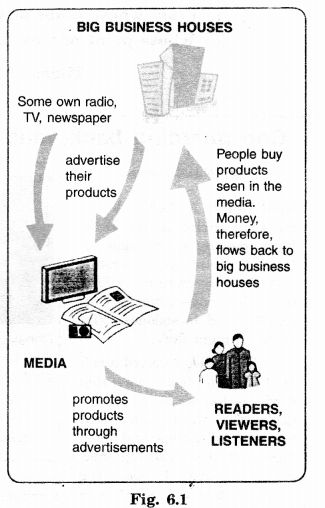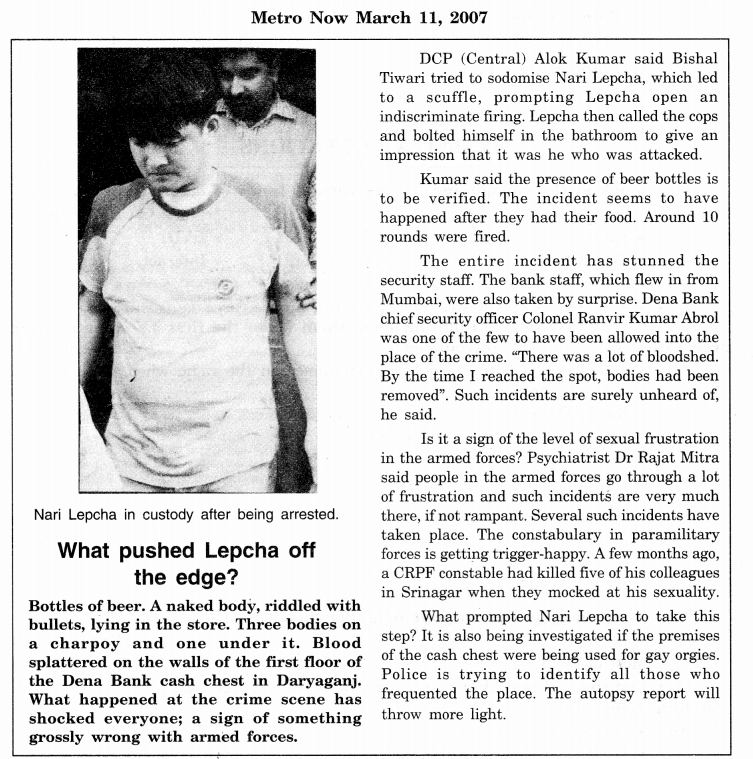NCERT Solutions for Class 7 Social Science Civics Chapter 6 Understanding Media are part of NCERT Solutions for Class 7 Social Science. Here we have given NCERT Solutions for Class 7 Social Science Civics Chapter 6 Understanding Media.
| Board | CBSE |
| Textbook | NCERT |
| Class | Class 7 |
| Subject | Social Science Civics |
| Chapter | Chapter 6 |
| Chapter Name | Understanding Media |
| Number of Questions Solved | 17 |
| Category | NCERT Solutions |
NCERT Solutions for Class 7 Social Science Civics Chapter 6 Understanding Media
NCERT TEXTBOOK EXERCISES
Question 1.
In what ways does the media play an important role in a democracy?
Answer.
Media plays an important role in a democracy in the following ways:
- It provides information about the working of and decisions taken by the government for the welfare of the citizen.
- It also makes the government aware of the public reactions to its working and / decisions.
- It discusses different events of public interest in detail taking place in the country and all over the world.
Question 2.
Can you give this diagram a title? What do you understand about the link between media and big business from this diagram?

Answer.
- Title to the diagram:
Media and Big Business Houses. - The link between media and Big Business:
There is a strong link between media and big business/business house because of the following reasons:- Most of the media (Newspapers, magazines, news channels) are owned by big business houses. e.g., Hindustan Times by Birla group.
- Big business houses finance the media in a big way.
- They pay heavy amounts to the media for their advertisements.
- They provide political, financial, social, and moral support.
- In return, the media propagates its policies and programmes.
- They publish and advertise their products.
Question 3.
You have read about the ways in which the media ‘sets the agenda’. What kind of effect does this have in a democracy? Provide two examples to support your point of view.
Answer.
Media, the fourth pillar of democracy, sets the agenda to focus on the issue of public interest. This agenda sometimes has positive effects on a. democracy. For example,
(1) Media published reports about alarming levels of pesticides in Cola drinks. The media declared this fact despite the government’s resistance that Cola drinks were unsafe. Thus, the media’s agenda helped us by focusing on an issue that affects our lives.
(2) The media sometimes fails to set agenda to raise issues significant in democracy. For example, it publishes a wide coverage about the ‘World Cup’ but at the same time it does not give attention towards the issue like drinking water as a major problem, the people are facing.
Question 4.
As a class project, decide to focus on a particular news topic and cut out stories from different newspapers on this. Also, watch the coverage of this topic on TV news. Compare two newspapers and write down the similarity and differences in their reports. It might help to ask the following questions:
(a) What information is this article providing?
(b) What information is it leaving out?
(c) From whose point of view is the article being written?
(d) Whose point of view is being left out and why?
Times of India, March 11, 2007


Answer.
(a) Particular News: March 11, 2007
Times of India Metro Now
“Cop guarding Bank Vault “What pushed Lepcha off the Edge.”
goes berserk, kills 5 mates.”
(b)
(i) Information
A Sikkim Police constable deputed Nari Lepcha kills 5 mates
at Darya Ganj, Dena Bank Branch kills 5
mates to escape unnatural sex acts.
(ii) Information leaving out
Attempt to repeat the unnatural acts. The motive of murder not yet clear.
(c) Point of view
General public General public
(d) Point of view is left out
Police Police
INTEXT QUESTIONS
Question 1.
Look at the college and list six various kinds of media that you see. (NCERT Page 71)
Answer.
- Radio.
- Television.
- DVD.
- Transistor.
- Computer.
- Internet.
- Newspapers, magazines.
- Periodicals.
Question 2.
Ask older members of your family about what they used to listen to on the radio when there was no TV around. Find out from them when the first TV came to your area. When was cable TV introduced? (NCERT Page 71)
Answer.
- They used to listen to following programmes on the radio when there was no television around.
- Radio Ceylon
- Ap Hi Ke Geet (आप ही के गीत )
- Binaca Geet Mala ( बिनाका गीत माला )
- Vividh Bharati
- Hawa Mahal ( हवा महल )
- Man Chahe Geet ( मन चाहे गीत )
- Radio Ceylon
- The first TV came in 1984 in our area.
- Cable TV was introduced in 1990 in our area.
Question 3.
How many people in your neighbourhood use the internet? (NCERT Page 71)
Answer.
Most of them.
Question 4.
List three things that you know about some other part of the world from watching television. (NCERT Page 71)
Answer.
- Earthquake in Nepal.
- Tornado in Oklahoma, May 2013, the disappearance of aeroplane MH370.
- Cannes film festival, 2013.
Question 5.
Can you list three different products that are advertised on your favourite TV programme? (NCERT Page 72)
Answer.
Yes, Tea, clothes, Snacks, Cold drinks.
Question 6.
Take a newspaper and count the number of advertisements in it. Some people say that newspapers have too many advertisements. Do you think this is true and why? (NCERT Page 72)
Answer.
- Hindustan Times.
- Number of advertisements: 70
- Some people say correctly but it is necessary otherwise the cost of the newspaper will be so much that most people would not be able to buy newspapers.
Question 7.
Are the above stories in the two newspapers similar? And if not, why not? What, in your view, are the similarities and differences? (NCERT Page 74)
Answer.
No, they are not similar. A news report in the News of India report, the story is about the crackdown on polluting factories while in the Indian Daily Report, the story is about the closure of factories which led to unrest.
Differences
- A report in the News India Report says that closure will result in a clean and green city.
- The closure will lead to unemployment in Indian Daily Report.
- Relocation must be done.
- The places of relocation have no facilities.
Similarities
- Both the reports/stories are related to factories.
- Both reports indicate protests by owners and workers of the factories.
- Relocation has been dealt with in both reports.
Question 8.
If you read the story in the News of India, what would you think about the issue? ‘ (NCERT Page 74)
Answer.
The issue is the pollution caused by polluting factories.
- Factory owners and workers protested violently against the crackdown on polluting industries.
- The government had already declared these industries illegal.
- But it acted hastily to close them down.
- In view of the clean and green city, it is necessary to close them down.
Question 9.
Do you think it is important to know both sides of the story? Why? (NCERT Page 75)
Answer.
Yes, because only then we can form a balanced opinion about an issue.
Question 10.
Pretend that you are a journalist for a newspaper and write a balanced story from the two news reports. (NCERT Page 75)
Answer.
Balanced Story
- The government orders closure of polluting factories in the city. The pollution had already assumed alarming proportions.
- Factory owners and workers protested violently against the closure. The city life came to a standstill.
- For a clean and green city, the closure of factories was essential.
- The government should have relocated the factories to suitable locations with a proper time frame.
Question 11.
What does TV do to us and what can we do with TV? (NCERT Page 75)
Answer.
- In many of our houses, TV is always on.
- We form an impression about the world around us by seeing the TV7.
- It is like a ‘window to the world’.
- TV has different types of programs like movies, soap operas, game shows, reality TV shows like News, sports, and cartoons.
- Before, in between, and after each programme there are advertisements.
- TV shapes our views of the world, our beliefs, attitudes, and values.
- It gives us a partial view of the world.
- While we enjoy our favourite programmes, we should always be aware of the large exciting world beyond our TV screens. There are so many happenings beyond the TV.
- There is a world beyond film stars, celebrities, and rich lifestyle, a world that all of us need to reach out to and respond to in various ways.
- We need to be active viewers, who question whatever we see and hear, while we may enjoy it too.
Question 12.
What is the consequence of the media ‘setting the agenda’ by reporting on the Fashion Week rather than the slum demolitions? (NCERT Page 77)
Answer.
They earn huge amounts of money from the fashion week.
Question 13.
Can you think of an issue that does not seem important to you because it is never featured in the media? (NCERT Page 77)
Answer.
- Rising prices of essential commodities, and
- Rising crime graph in metropolitan cities.
We hope the NCERT Solutions for Class 7 Social Science Civics Chapter 6 Understanding Media help you. If you have any query regarding NCERT Solutions for Class 7 Social Science Civics Chapter 6 Understanding Media, drop a comment below and we will get back to you at the earliest.